The Effectiveness of AID in Conflict Zones
Added on 2020-06-04
43 Pages19410 Words40 Views
DISSERTATION: THEEFFECTIVENESS OF AIDIN CONFLICT ZONES

TABLE OF CONTENTSCHAPTER 1: INTRODUCTION....................................................................................................11.1 Background of the study...................................................................................................11.2 Aims and Objectives of the study......................................................................................2Aim:................................................................................................................................2Objectives:.....................................................................................................................2Research questions:.......................................................................................................21.3 Rationale of the study.......................................................................................................31.4 Significance of the study...................................................................................................31.5 Specification of research...................................................................................................41.6 Structure of Dissertation...................................................................................................5CHAPTER 2: LITERATURE REVIEW............................................................................................72.1 Introduction..............................................................................................................72.2 Aid leads to conflict aggravation in regions.............................................................7Concept of humanitarian................................................................................................9Principle of humanitarian..............................................................................................102.2 Effectiveness of humanitarian in Myanmar and Syria.............................................10Positive and negative effect of humanitarian aid on conflict development...................11CHAPTER- 3 RESEARCH METHODOLOGY...............................................................................20Introduction..................................................................................................................20Research philosophies..................................................................................................20Research approach.......................................................................................................21Research design...........................................................................................................22Research techniques-...................................................................................................23Data collection-............................................................................................................23Data analysis-...............................................................................................................24Sampling-.....................................................................................................................25Research limitation-......................................................................................................25CHAPTER 4: DATA ANALYSIS.................................................................................................274.1 Introduction............................................................................................................274.2 Analysis and finding...............................................................................................27CHAPTER 5: CONCLUSION AND RECOMMENDATIONS............................................................345.1 Conclusion..............................................................................................................345.2 Recommendations..................................................................................................36REFERENCES.........................................................................................................................39

CHAPTER 1: INTRODUCTION1.1 Background of the study The situation of disagreement as well as an argument on the specific topic amongtwo parties is known as conflict. In this both the conflicted party not reaches up to thesolution where different kinds of help taken by them. It can arise between two persons,companies or countries. For resolving it generally, external parties are hired which analysesabout the situation and come at the possible as well as the effective solution. Aid is animportant aspect which makes a contribution to the dispute resolution up to the greaterextent. The present dissertation emphasises on the aid through which conflicts solvedamong regions. Further, the situation of the conflict is considered between and within acountry rather than individual or group of people. The concept in which help by one party isdone for another in order to make a solution of the dispute is considered as aid. There areseveral types of aids available through which conflict in region or country solved up to thebetter level (Malkki,2016). Moreover, various aid includes financial, humanitarian, foreignetc. which are effective. In the financial aid, the third party gives monetary support to thesuffered or conflicted country. Humanitarian is one of the highly important where peoplehelp in terms of monetary and non-monetary both. The aid in which material, as well as logistics assistance, is given to those regionsand people who need help is known as humanitarian aid. It is one of highly effective aspectthrough which problems and issues are resolved properly within the country. It is one type ofhelp for the short period of time. Apart from this, a key objective of the humanitarian aid isto save the life of suffered people who are suffering from disaster, water flood, wars,famines etc. In this, donations are given by the human for solving issues of suffered peopleand food items are also provided up to the larger extent (Rieff, 2013). Therefore,humanitarian aid is of the both types of monetary and non-financially which support forconflict resolution. The present dissertation mainly focuses on the humanitarian aid where ithas been analysed that it is up to which level helpful to make solutions within conflictedgions. Along with this, foreign aid party is also taken into consideration in the study throughwhich conflicts within the countries are solved. It shows that how foreign aid partysupportive to reduce vicious cycle of disputes as well as its development in a country.In the world, wide range of issues and conflicts arisen which create a negative impacton economic growth rate up to the higher level. The present dissertation looks upon conflictand aid comes into consideration within Syria and Myanmar countries in the world. Thesituation of dispute arisen in both the countries are regarding to the Muslim unity wherethey create violence. Further, the reason of doing violence activities by them is for gettingas well as using their fundamental rights which are taken by government (Hyndman, 2015).1
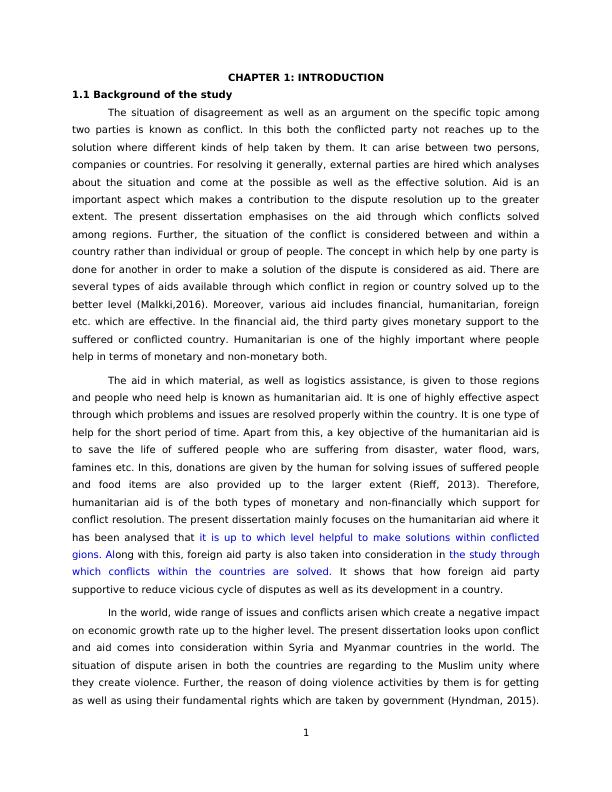
Humanitarian aid provided to Myanmar country by other regions through which thisdemocratic conflict resolve up to the certain level. Therefore, the Muslim community ofMyanmar able to use their humanity and fundamental rights within the region. Apart fromthis, when talking about the Syria conflict then in this Iran country is also included. As perthis case, population want that in Syria and Iran only Muslim community will live where bigissues came into consideration. In order to make a solution of Syrian conflict, humanitarianaid given by the US, Russia etc. Moreover, with the help of assessing the impact of such aidwithin both the country's conflict condition aim of the study will be achieved. 1.2 Aims and Objectives of the study Aim:To analyse the effectiveness of humanitarian aid in resolving the issues of conflictedregions: A case study on the conflict in Syria and Myanmar. From the above stated aim of the study, objectives are to be framed so that aim willbe achieved in an appropriate direction. Therefore, objectives of the present dissertation arestated below:Objectives:To identify that aid leads to conflict aggravation in regions.To assess the contribution of humanitarian aid in ending the conflict.To ascertain whether foreign aid party is effective in terms of resolving the state of avicious cycle in conflicted situation and leads to development. To determine the effectiveness of aid if aid comes during the conflict as opposed toafter conflict.In the present dissertation, those things which will be covered are presented on thebasis of the objectives properly. Further, these are prepared by considering the aim of thewhole study in a proper way. Apart from this, on the basis of objectives following researchquestions are framed:Research questions:Does Aid lead to conflict aggravation?Can humanitarian aid truly end a conflict?Is foreign aid party to a vicious cycle of conflict and development?Does the effectiveness differ if aid comes during the conflict as opposed to afterconflict?2
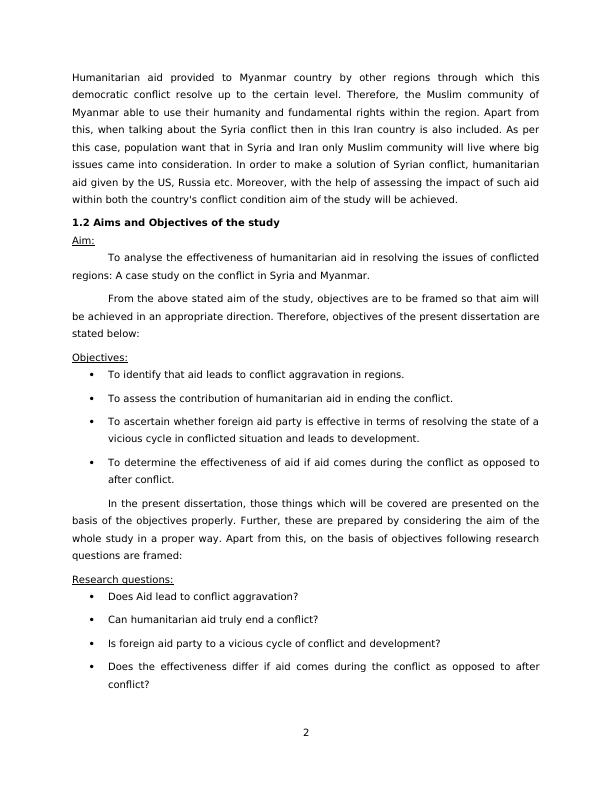
1.3 Rationale of the study Within country or group of people, several kinds of issues and conflicts come intoconsideration which affects the economy adversely. Reason behind conducting the presentstudy is to reflect about disputes arisen within two countries which are Myanmar and Syria.In this, the government of Myanmar not provided all the human and fundamental rights tothe Muslim people for using. Due to this, they start to create violence within a region whichlead to arising issue of conflict. In the present times, Syria is also facing this particularproblem. The study analyses about the humanitarian aid along with foreign aid provided byseveral countries to the conflicted regions. As this kind of aid given up to the suffered peoplethe then issue of conflict resolved highly within regions. Further, basic rationale behindconducting the current study is for identifying a level of effectiveness of humanitarian aid inthe conflicted region (Kennedy, 2015). When looking at the ways of solving disputes thethere are several methods available which support to Myanmar and Syria problems. In thesecountries, humanitarian aid is also taken into consideration which is assessed. With the helpof this study, the reader able to determine that in which ways humanitarian aid is supportivefor regions in order to make conflict solution. Hence, the reason for making analysis of theresearch is to analyse the impact of material, as well as logistic activities performed by thehuman, are up to which level effective for conflict regions. 1.4 Significance of the studyThe present dissertation is based on the effectiveness of humanitarian aid on theconflicts arisen within a country. The problem of the dispute taken into consideration forconducting the present analysis is the Myanmar and Syria region. For making effectivesolution and end of such conflicts humanitarian aid provided to the mentioned countries.The study is identifying that up to which level this kind of aid is helpful to the sufferedpeople from violence done by Muslim community in Myanmar. Due to this, the analysis issupportive of the affected people for assessing that in which ways they come out from theconflict (Barnett, 2016). Along with this, the population who not know about thehumanitarian aid will also supportive for getting knowledge about this. Under this type ofconflict solution, several kinds of ways and aspects included which is also helpful for thepeople. Apart from such all the things, the study is important for making a fruitful analysis ofthe data which gathered. The study will be appurtenant for other readers and researchersalso to ascertain the impact of humanistic aid made upon a conflict of Myanmar and Syriacountries. Once the study completed and published then useful for those investigators whomake analysis using the secondary information. Therefore, it can be said that for secondarydata users the present dissertation will be highly significant. Along with this, in order to do3

further study on the topic of humanitarian aid used for region conflict resolution also theresearch is supportive (Ticktin, 2015). In case, a new investigator not having adequateknowledge in context to the aid in form of logistic and material assistance by people thenusing this research able to make clearance about this. Moreover, when the human goes forcontributing to region dispute resolution then the present research is helpful for getting itseffectiveness. Hence, it can be said that study of the impact on conflict of humanitarian aidis highly significant for present and future both research. 1.5 Specification of researchThose methods, as well as tools which will be hereby considered in conducting properresearch, are presented in this aspect. Further, the specification of the current study andresearch are mentioned below:Research approach: There is two type of research approach that is inductive anddeductive. The research which includes the qualitative data will always apply theinductive approach of the research which helps them to analyse the result on thedifferent theory based.Research design: There is a different type of research design that is available tothe researcher in order to analyse the information, facts, and figures which arerelated to the chosen subject (Fassin, 2016). The different type of research design isdescriptive, exploratory and co-relation. The descriptive research design has beenselected for the present dissertation. Research philosophy: It consists of two different terms i.e. epistemology anddoxology. There are two types that are interpretivism and positivism. For thisdesertification, interpretivism philosophy have been used which provide the flexibleresearch framework and help researcher to believe that what is the reality.Data collection: There are two ways of collecting the data that is primary andsecondary (Rieff, 2013). Primary data is always being collected from the first timewhereas the secondary data is collected from the different sources where the data isalready being collected. Here primary data is being gathered with the help ofinterview made from the respondent.Data sampling: It is not possible for the researcher to collect the data from thelarge population so he has collected the data from the samples that are 10 harbourrohingya refugees and 5 aid providers of Syria and 5 aid servers of Myanmar.Data analysis: It is considered as the technique to analyse the data which is beingcollected from the primary sources or secondary sources (Hyndman, 2015). For thisdesertification thematic analysis is done.4
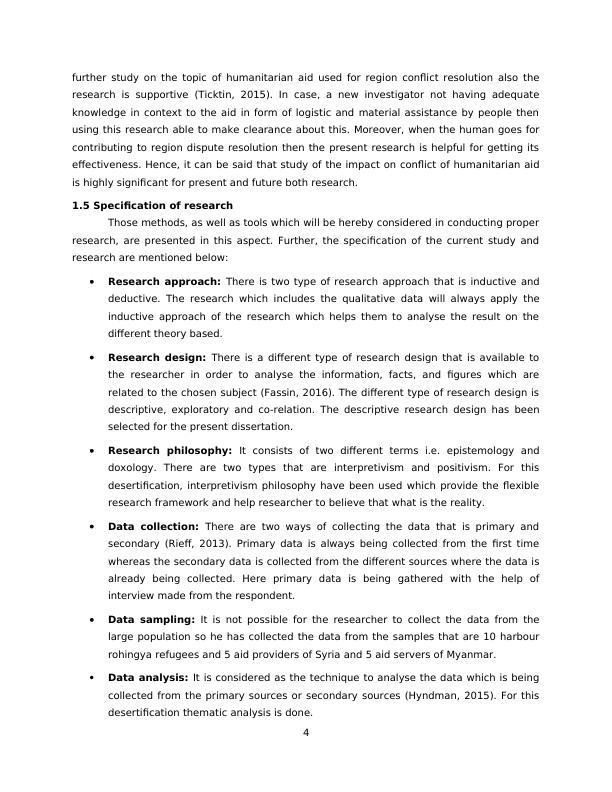
1.6 Structure of DissertationThere are various chapters that have been included in the dissertation, these playvery important role in completing the study in the effective and efficient manner. Thedifferent chapters that are included in it, that are as follows: Chapter 1: Introduction: The research is started with the introduction of the humanitarian and effect ofhumanitarian on the Myanmar and Syria. The aim, research question and objective is framedin chapter 1. The goal of the investigation is discussed in this chapter, the researchmethodologies are involved in the end and that ate included in the present research.Chapter 2: Literature review: The next chapter, the several anthers are being considered as the subject matter andfurther, they are discussed. The depth research is made in this chapter where the view pointis regarded and criticism is made. Apart from this, various kinds of the articles related to thistopic are gathered initially and reviewed them. In addition to this, books and journals abouthumanitarian aid are also analysed in this chapter. Chapter 3: Research methodology: There are several tools and method is being used by the research in the dissertationare included in this chapter. This will also justify the selection of appropriate technique inthe research. By using the methods of research like approach, investigation, philosophy,design etc. study is conducted. Chapter 4: Data analysis: All the data which is collected from the primary and secondary sources is beinganalysed in this chapter. Thematic data analysis is being used with the help of chart andgraphs. Moreover, it one of the pivotal chapter of the whole study because it considered asthe base of conclusion. Chapter 5: Conclusion and recommendation: With the support of chapter 1 to 4, the researcher will summarise the whole study. Atthe at of dissertation, every person will serve some recommendation that helps to improvethe disadvantage and problems that have been held in the research. 5
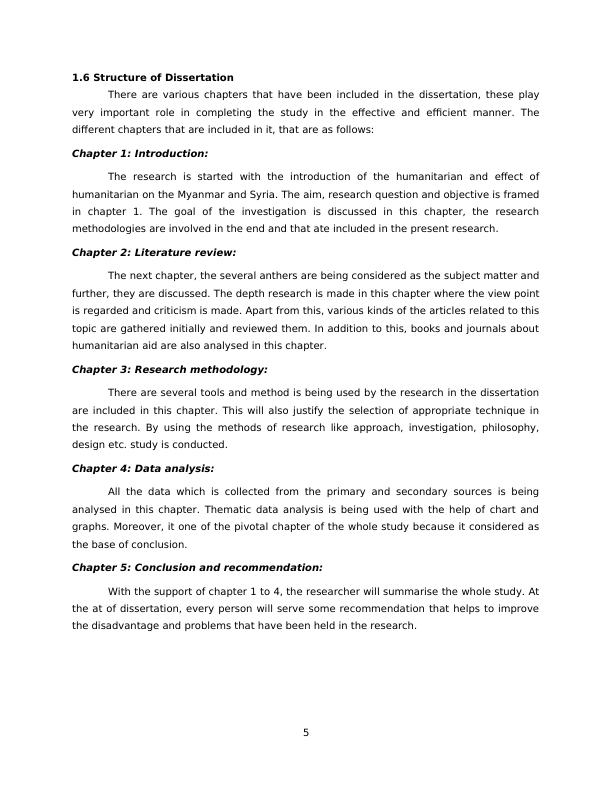
CHAPTER 2: LITERATURE REVIEW2.1 IntroductionA literature review is one of the important chapters of the dissertation whichincorporate different types of information. It helps the researcher in gather a large amountof data and apply the same in respect to get the valid outcome. The present study is basedon to analyse the effectiveness of humanitarian aid in resolving the issues of conflictedregions: A case study on the conflict in Syria and Myanmar Therefore, this chapter coversecondary information on the basis of aim and objectives. Along with this different themeswill be prepared on the basis of objectives so that information can be gathered for producingthe valid outcome. However, the effectiveness of Humanitarian aid in ending conflict isassessed.2.2 Aid leads to conflict aggravation in regions.According to the view of Kinninmont and House, (2014) Aid is the support providedby the non government organisations to help the areas in danger or the regions facing theissues of conflicts between the government and the local groups taking the region undercontrol. The local groups or the terrorist organisation against the political parties in thecountry creating problems and demanding the country to be called as an Islamic state. Inthe regions of Syria the government and pro- government forces are creating problems forthe civilians. They are attacking the rescue troops and the convoys providing aid to thepeople stucked in the different regions. Earlier the government has prevented more then70000 medical equipments being delivered into the besieged areas according to UN report.People of Syria are facing many problem and are forced to leave the areas formed by therelief agencies. Armed agencies are stopping the rescue teams and are not allowing theoutside organisations to deliver the aids to the people of this region. As per the view ofGleick, (2014) the forces are scared that if the outside organisations will provide aid in thecountry it will create problems for them and affect their presence. The aids are constantlybeing delivered and the armed forces are attacking the convoys and unloading the aid tomake sure it does not reach the people for their support. The armed forces do not want anyinvolvement of outside organisation and provide any kind of relief to the civilians. If theagencies are successful in providing aid to the civilians it will be a huge backlash for thearmed troops and their power would be deceased. They are not in favour of the organisationto help the civilians and are attacking the areas besieged by the government. Al-Salem and et.al (2016) states that in Syria conflicts are also increasing due to theinvolvement of government as well as UN organisation by providing humanitarian aid to thecivilians. As the demand of aid increases in the country and involvement of governmentagencies increases it creates problems for the armed forces like ISIS. It is the group who istrying to take control over the country and destroying the besieged places of government
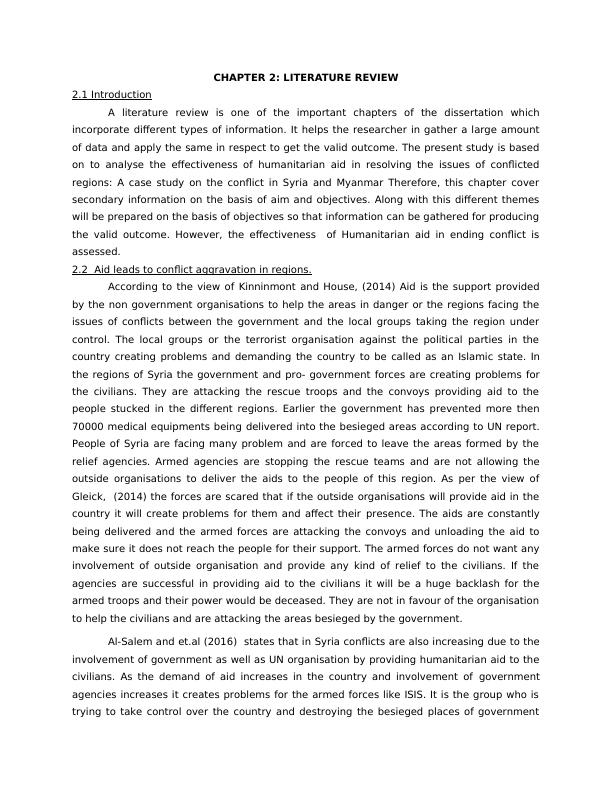
End of preview
Want to access all the pages? Upload your documents or become a member.
Related Documents
Joint Ventures within the UK Construction Industrylg...
|36
|12694
|362
Decline in Publishing Industry of Sri Lankalg...
|39
|8517
|71
The Efficacy of ADR in Addressing Challenges Faced by Microfinance Institutions (MFIs) in Kenyalg...
|39
|9956
|288
Case Study On Marriott hotellg...
|88
|29755
|40
Selecting AHP Techniques for Supply Chain Managementlg...
|41
|9138
|212
Dissertation | Global Security & Information Securitylg...
|63
|15552
|39
